skip to main |
skip to sidebar
In Part 5, I described our activities in Mawlamyine before we checked in at the Cinderella Hotel for our last night in Mon state.
Thursday 23rd April April 2015
On Thursday morning, we enjoyed an excellent breakfast at the Cinderella Hotel before setting off by car to return to Yangon. The Doctor had allowed for more sightseeing on the way so we first stopped at the Win Sein Taw Ya Pagoda which houses the ‘World’s Largest Reclining Buddha’. This was my third visit to the site - I'd first visited in 2012 (described in the post South of Mawlamyine, Burma). The following year, Doctor Hla Tun had carried out distributions to children from Mudon Township at the Win Sein Taw Ya Pagoda and this is reported in the post Orphans and Vulnerable Children Project in Myanmar. During my Burma trip in 2014, the Doctor and I made another visit (briefly described in the post South from Mawlamyine by Car).
The straight road leading to the pagoda has an impressive line of full-size painted concrete statues of monks, each carrying an offering bowl. As you get nearer to the reclining Buddha, the line of statues traverses an arch over the approach road and continues into the monastery grounds.
 The line of full-size painted concrete statues of monks.
The line of full-size painted concrete statues of monks.
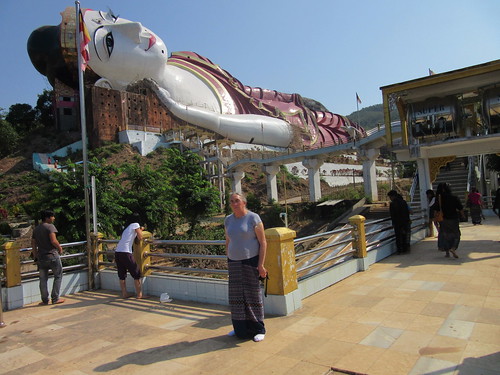 Jan at the at the Win Sein Taw Ya Pagoda in on this trip.
Jan at the at the Win Sein Taw Ya Pagoda in on this trip.
After the necessary photographs had been taken, we continued north. The Doctor had intended that we would visit the famous 'Golden Rock' at Kyaikto, but Fate intervened.
I had dozed off as we drove north when it happened. There was a loud explosion and I thought "That's not a dream!" I opened my eyes in time to see both front air bags inflating. Our driver held the car in a straight line whilst braking as an acrid smell and clouds of dust filled the cabin. I had no idea what had happened but, as soon as we came to a stop, I deemed it prudent to exit the car promptly. Nobody seemed hurt although we were all rather shaken. Looking at the vehicle, the left front wheel had twisted 90 degrees from its usual fore-and-aft position and the tyre was shredded so the car had slumped down at an unusual angle.
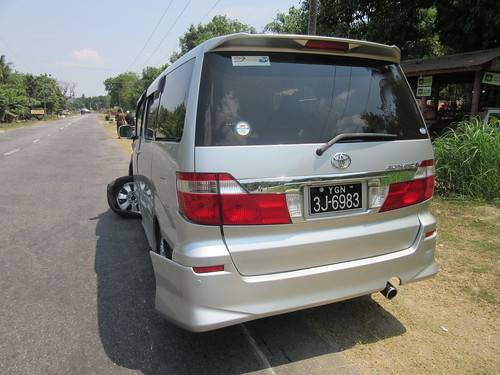 Our car was severely damaged.
Our car was severely damaged.
I was told that a car travelling in the opposite direction had 'side-swiped' our car then continued along the road before turning on its side and coming to a stop, after which the driver ran off. We'd stopped in a village near a roadside shelter where Emily and I waited while the others came up with a plan. Of course, all the local people came to inspect the damage. After a while, a policeman arrived on a small motor bike.
 "... all the local people came to inspect the damage ..."
"... all the local people came to inspect the damage ..."
We were invited to wait in the house of a local resident just opposite. Emily and I were made comfortable and electric fans were brought, since the day was very hot. I'd been asleep before the accident and, perhaps because of the shock, I found it difficult to take much notice of what was going on around me but eventually I understood that a car had been summoned from Yangon to rescue us but it would be at least four hours before it arrived. Doctor Hla Tun decided that we would take lunch while we waited, so a three-wheel motor cycle taxi was summoned and we all piled aboard for a journey of a mile or two back the way we had come to a roadside cafe. We were shown to a private dining room attached to the cafe where we enjoyed a relaxing, leisurely lunch. I felt much revived after the meal. Eventually, the motor cycle taxi took us back to our sorry-looking car which still held our heavy luggage and our 'relief car' arrived from Yangon.
 Our sorry-looking Toyota after the accident.
Our sorry-looking Toyota after the accident.
Luggage was transferred to the 'relief car' and we set off for Yangon, with two of our party remaining behind to arrange the 'ferrying' of the badly-damaged car to Yangon for repairs. Our trip to the 'Golden Rock' was, of course, cancelled and we drove through Kyaikto on the main road without stopping. It was dark by the time we arrived at the junction with the dual carriageway near Bago and it was decided to stop for a snack before the final 'leg' of our journey back to Yangon, where Emily and I were to stay at Doctor Hla Tun's house.
It was my first visit to the Services here. Although there were a number of long-distance buses in the car park, the large cafe wasn't very busy.
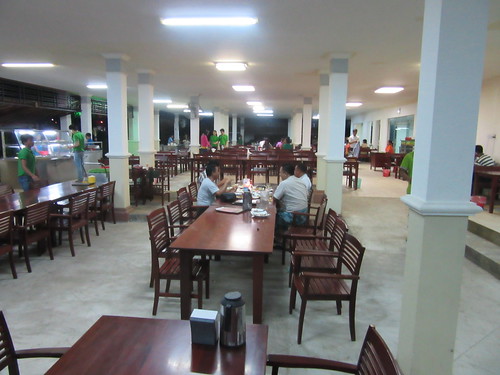 The bright, airy cafe at the Services.
The bright, airy cafe at the Services.
The Services were very 'western' in style and the only reminder that we were in Myanmar came when I visited the toilets. Western-style toilets had been provided, rather than the ground-level 'squat' toilets more common in Asia. A simple graphic was displayed reminding users that attempting to 'squat' on western-style toilet bowls may lead to injury.
 A graphic reminder of the pitfalls of misunderstanding the use of 'western' toilets.
A graphic reminder of the pitfalls of misunderstanding the use of 'western' toilets.
Late evening, tired but fortunately unhurt, we arrived at Doctor Hla Tun's house. I was keen to get to bed because, the following morning, we were to catch the 07:20 domestic flight from Yangon to Nyaung Oo where we would transfer by road to the Bagan Medical Clinic.
Go to next post.
All my posts on the 2015 trip to Myanmar can be found here.
My pictures
The World's Largest Reclining Buddha, Myanmar
(includes pictures from 2012 and 2015).
By road to and from Mon State.
[Actually first posted 9th June 2015, but timestamp amended to place posts in event order]
In Part 4, I described our journey to Setse Beach, where we stayed at the curiously-named 21 Paradise Hotel.
Wednesday 22nd April 2015
After a refreshing night's sleep, we had a good breakfast in the hotel restaurant, overlooking the beach.
 View of our hotel from the beach.
View of our hotel from the beach.
Setse has a broad, sandy beach, flanked at each end by small headlands. The rooms of our modern hotel, grouped as a series of separate 'cottages' extended for some distance along the beach. Further along the beach, we could see bamboo houses and temples. There were already a number of people enjoying the beach, including one motor cycle being driven in a surprisingly restrained manner and a horse with its keeper apparently selling beach rides. The horse seemed to be enjoying the morning as much as the father and young son riding. A group of three dogs were also checking out the interesting scent trails on the sands. At the water's margin, small waves were breaking and, just offshore, a number of small fishing vessels were gathered.
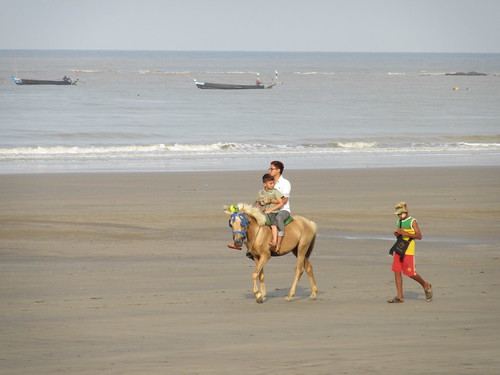 Setse Beach.
Setse Beach.
We checked out of the 21 Paradise Hotel, loaded up the car and set off for Mawlamyine. At Mawlamyine, two Distributions were planned - the first at the large Drop In Centre at Hlaing, the second at the smaller Centre called 'Future Generation'. I'd been to both locations before in 2014 (described here).
During my visit in 2014, the Drop In Centre at Hlaing had been bursting at the seams with over 400 children attending for the Distribution. This time, to better accommodate the numbers at the ceremony, a large covered area had been temporarily erected in the field outside the permanent building, comprising a series of collapsible, steel-framed canopies supplemented by bamboo-framed extensions. The school uniforms and stationery had already been made up into labelled 'kits' in school bags by the Centre's volunteers and placed on a low 'stage'. At the rear of this 'stage' a large banner, in English and Burmese, declared "7th Donation Ceremony for the students who need aids in 2015-2016 academic year at Hlaing area by the support of Dr. Hla Tun and Group".
All the children were patiently waiting in the temporary covered area, seated on the ground which had been covered with a series of mats. To one side, a table with a range of refreshments had been set up in front of a row of chairs intended for Doctor Hla Tun and his team.
 A view of part of the temporary covered area at Hlaing, viewed from the permanent building.
A view of part of the temporary covered area at Hlaing, viewed from the permanent building.
First, in the Drop In Centre, Doctor Hla Tun made donations of financial support towards the education costs of five senior girl students.
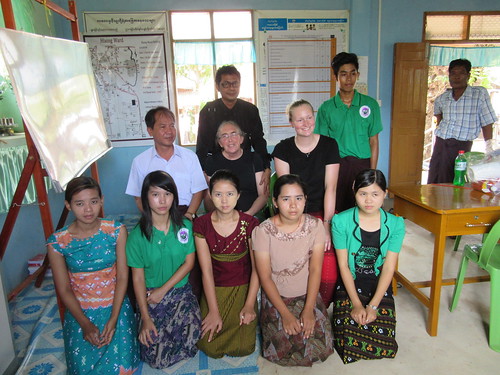 The five senior girl students who received assistance.
The five senior girl students who received assistance.
A television news team from the local Sky Net station's 'Up to Date' programme were recording the event and conducting interviews, as they had on my previous visit.
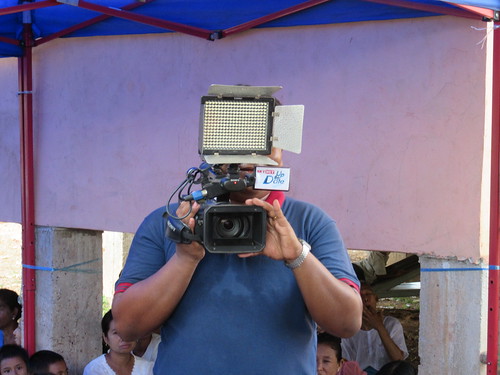 The Sky Net cameraman at work.
The Sky Net cameraman at work.
Then followed the usual fairly frantic period when the visitors presented the gifts to the children, with volunteers from the Centre ensuring that each child received the right 'kit' appropriate to the age and sex of the recipient. The children then changed into their new school uniforms for the 'group shot'.
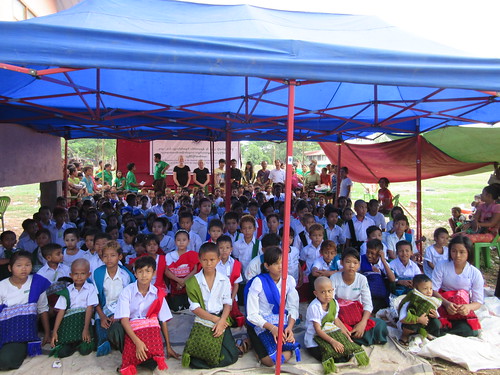 The smartly-attired children display their new school bags.
The smartly-attired children display their new school bags.
It was decided to take more informal pictures of the group in the field so we all lined up again whilst pictures were taken on numerous cameras to adequately record this important annual event.
 "Everybody wave": The Drop In Centre (and the temporary covered area) can be seen in the background on the left.
"Everybody wave": The Drop In Centre (and the temporary covered area) can be seen in the background on the left.
The work of the Drop In Centres is only made possible by volunteer staff and Doctor Hla Tun made donations to support these volunteers.
 Donations to volunteers at Hlaing D.I.C.
Donations to volunteers at Hlaing D.I.C.
Hlaing Ward, with a population of around 20,000 is one of the poorer Wards in the Township of Mawlamyine. To gain a better idea of conditions in the area, we went on a walk around the Ward, calling at a number of 'O.V.C. Houses' which provide accommodation for some of the children who are without families. Once again, Doctor Hla Tun made donations to support this work.
 An O.V.C. House. The young boy is proudly showing off his new school uniform and school bag, presented to him earlier at the Drop In Centre.
An O.V.C. House. The young boy is proudly showing off his new school uniform and school bag, presented to him earlier at the Drop In Centre.
We then returned to the centre of Mawlamyine where we stopped at a large, busy cafe to take lunch. All the waiters were boys, some looking very young. Young, male waiters seem very common in Burma, as is a tendency for them to shout instructions across the cafe at the top of their voices.
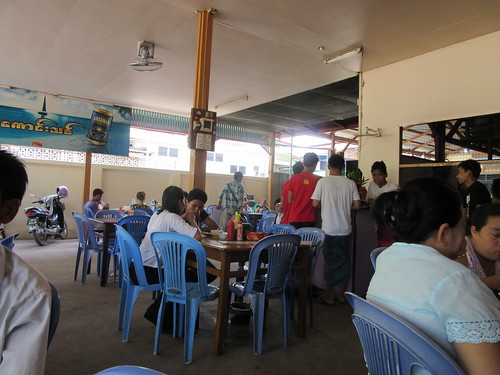 Lunch in Mawlamyine.
Lunch in Mawlamyine.
Our car then look us to the 'Future Generation' Drop In Centre. Once again, we were made very welcome and, for me, it was a chance to see once again staff I'd met the year before.

The Manager of 'Future Generation'.
The Distribution proceeded with the usual air of joyful chaos, as the children changed into their new uniforms for the obligatory group photograph.
 After the distribution, the children pose with their school bags wearing their new uniforms.
After the distribution, the children pose with their school bags wearing their new uniforms.
Not far from the 'Future Generation' Drop In Centre, we made a visit to another O.V.C. House where Doctor Hla Tun also made donations. I believe it's thought that the problems of HIV/AIDS particularly affecting Mon State are due to the area's proximity to Thailand, which has experienced major problems with HIV/AIDS. Even where children themselves do not carry HIV, the incapacity or death of parents can have a devastating effect on the life of children, hence the importance of O.V.C. Houses and the availability of Drop In Centres. In the 'Future Generation' D.I.C. I'd notice a poster, largely in Burmese, but framed in English "Where there is Care, there is Hope". The 'Road to Mandalay' Social Contribution and Doctor Hla Tun became involved in Mon State to help to provide this care. I discussed some of the background to this in the post 'Road to Mandalay' co-operation with other organisations.
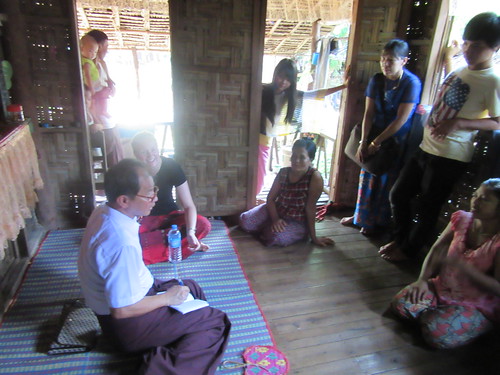 Visiting an O.V.C. House near 'Future Generation'.
Visiting an O.V.C. House near 'Future Generation'.
Doctor Hla Tun had arranged another hotel for the night so we drove to the centre of Mawlamyine and checked into the rather oddly-named 'Cinderella Hotel'. The staff were very friendly, the facilities quite good and the prices modest. After we'd settled in, we went by car to Strand Road, overlooking the water, for dinner. Strand Road (as I commented last year in my post last year here) "takes on a holiday atmosphere at sunset" and there were lots of people around, strolling and relaxing. Along one section, there was a very broad pavement which accommodated a series of open-air cafes where we look our evening meal. Some aspects of Western 'civilisation' being introduced into Myanmar are not appreciated by the writer. Looming over our pavement cafe was a huge advertising hoarding - a wide, tall steel tube supporting a massive large-screen T.V. which bathed our meal in flickering light whilst we were deafened by the insistent sound track. The food, however, was good. After our meal, we drove along Strand Road where, in the twilight, I spotted a ship moored just offshore involved in some sort of dredging operation.
 Strand Road at sunset, looking west.
Strand Road at sunset, looking west.
Then, it was back to the Cinderella Hotel and bed. On the following day, we were to head back north to Yangon.
Go to next post.
All my posts describing this trip to Myanmar can be found here.
My pictures
The following albums (on Flickr) include pictures relevant to this post:-
Setse Beach.
Hlaing Drop In Centre, Mawlamyine.
Around Hlaing Ward.
Around Mawlamyine 2015.
'Future Generation' D.I.C..
All my albums for this trip (except purely 'technical' ones) can be found here.
[Actually first posted 8th June 2015, but timestamp amended to place posts in event order. Text and pictures added 19-June-2015]
In Part 3, I described our activities at Ko Dut. On our way back north, the Doctor had intended that we should do some sightseeing.
Tuesday 21st April 2015
After the thunderstorm in the night, Ko Dut was a little soggy. We enjoyed breakfast at the Drop In Centre and then said 'goodbye' to our friends.
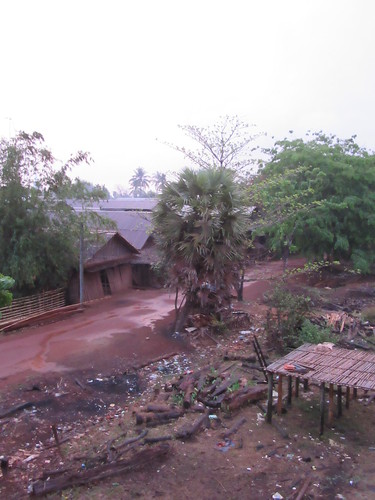
"Ko Dut was a little soggy".
We drove to a large monastery in the Thai style I'd not visited before with four spectacular Buddha figures seated around a tower. I was told that the monastery is largely funded from Thailand.

The tower with four seated Buddha images. Worshippers are just visible in the niches below the statue.
A forest of scaffolding hid a large reclining Buddha still under construction.
 Reclining Buddha under construction.
Reclining Buddha under construction.
Then we drove to Khaikhami Yele Paya, an important Buddhist Shrine built over the sea which I'd visited before in 2012 as described here and again in 2014 with Dr. Hla Tun as described in Last day in Mon State. This time, the sea level was higher than on either of my previous visits.
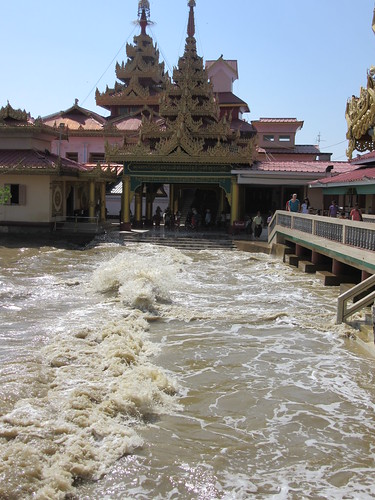
High Tide at Khaikhami Yele Paya.
I was pleased that we were also able to visit the 'Mirror Image' orphanage run by Sister Martha which we'd been to the previous year and which I described in the post Last day in Mon State. This work is partly supported by a British Charity - Aids Orphans of Myanmar.
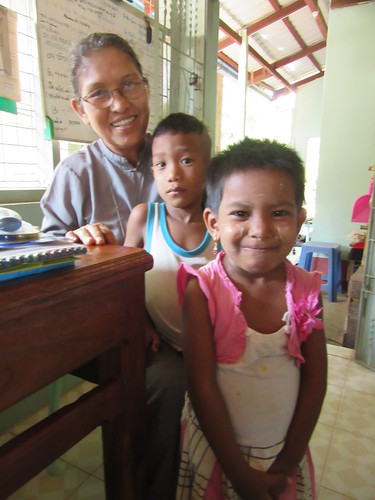
Sister Martha with two of the children.
We then drove to Thanbyuzayat where we took lunch in one of the many cafes.
 Lunch in Thanbyuzayat.
Lunch in Thanbyuzayat.
After an enjoyable lunch, we pressed on to the popular resort at Setse Beach. I'd been to the beach with Doctor Hla Tun once before (in 2014, described in the post Last day in Mon State) but this time we were to stay the night in a beach resort. After we'd checked-in (and after I'd had a welcome shower), we had a very pleasant meal in the roofed but open-sided hotel restaurant right next to the sandy beach. By this time, it was too dark for photographs but I took a few the following morning. I slept well in a 'proper' bed.
Go to next post.
All my posts on my 2015 trip to Myanmar can be found here.
My pictures
Thai-style monastery, Mon State.
Khaikhami Yele Paya.
Mirror Image Orphanage.
[Actually first posted 4th May 2015, but timestamp amended to place posts in event order: Pictures added 27-May-2015, text amended 5-June-2015]
In Part 2, I'd described our journey to Ko Dut. After snacks at the house of the manager of Ko Dut Drop In Centre, we went to look at progress at 'Mon School'.
Sunday 19th April 2015
I'd visited the Mon Ethnic Monastic School a year before (described in the post Visiting more Drop In Centres) when the wooden temporary school was still in use and the builders were completing the brick and concrete permanent building. The new building is now in use but, since our 2015 visit coincided with the school summer holiday, there were no pupils but one of the lady teachers showed us around. The building now has a concrete floor, entrance steps and a block of toilets connected to a septic tank.
 Arriving at Mon Ethnic School.
Arriving at Mon Ethnic School.
As is quite common, there is a single, long teaching area where a number of different classes are held simultaneously. We looked at a series of moveable, folding partitions which are being added, to give some isolation between the different classes.
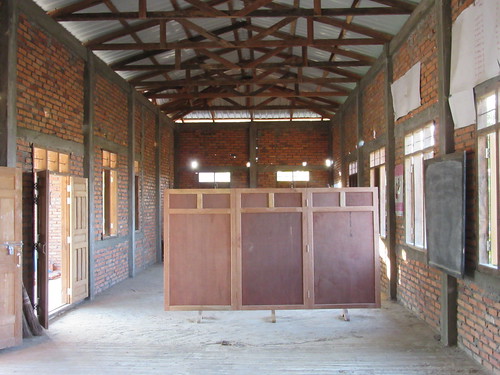 Mon Ethnic School, showing moveable, folding partitions in use.
Mon Ethnic School, showing moveable, folding partitions in use.
Leaving the school, we drove to the nearby fishing village on the Winyaw river to take in the attractive scene. I'd visited this village briefly on my previous trip. We watched a small passenger ferry bring a group of people across the river.
 Ferry arriving at the fishing village.
Ferry arriving at the fishing village.
There was no quay so the passengers had to clamber out into a foot or so of water, carrying their belongings.
We next went to the monastery of the head monk responsible for the Mon Ethnic school. He was actually in a review meeting with local people but we were invited in for a few minutes, where we sat on the floor in front of the head monk on his carved wooden chair. After Doctor Hla Tun had briefly discussed the support he'd provided to the school, we left so that the meeting we'd interrupted could continue.
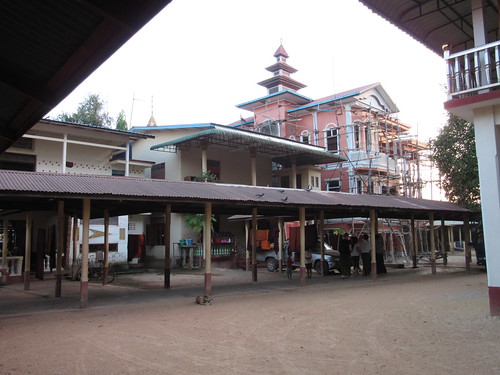 The meeting we joined was in the upper floor of the 2-storey building in the centre of the picture.
The meeting we joined was in the upper floor of the 2-storey building in the centre of the picture.
We then drove back to Ko Dut, this time to the Drop In Centre itself where we were to sleep. My first experience of sleeping on the floor at Ko Dut was during my visit in 2014 (described here). Since last year, the upper floor of the building has been added, thanks to assistance from the RTM Social Contribution. They had apparently chased up the builders so that the addition would be complete in time for our visit. The new upper floor formed a separate bedroom for Emily and I, approached by a rather vertiginous staircase. The usual sleeping mats were provided and a mosquito net.
 The new upper floor at Ko Dut D.I.C.
The new upper floor at Ko Dut D.I.C.
During the evening, the volunteers sorted the items for the distribution we were to make the next day, labelling each backpack with the intended type of recipient. By the time the task was completed, the ground floor was covered in blue backpacks.
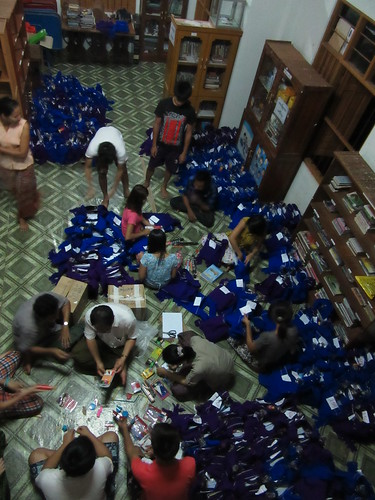
"... By the time the task was completed, the ground floor was covered in blue backpacks ...".
We all then went to the house of the manager of the Drop In Centre for our evening meal.
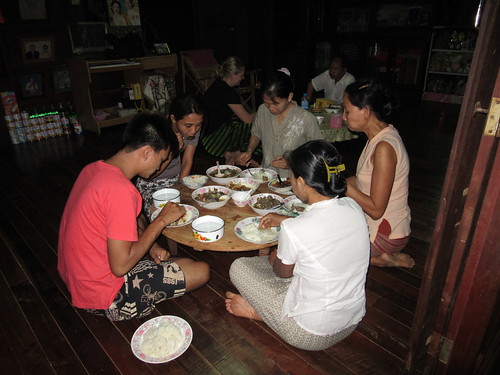 Evening meal at the manager's house.
Evening meal at the manager's house.
Monday 20th April 2015
After a reasonable nights sleep, we assembled for breakfast before the children started to arrive outside for the distribution of stationery, umbrellas and school uniforms, all packed into a traditional fabric school bag. As more children arrived, the excited chatter intensified.
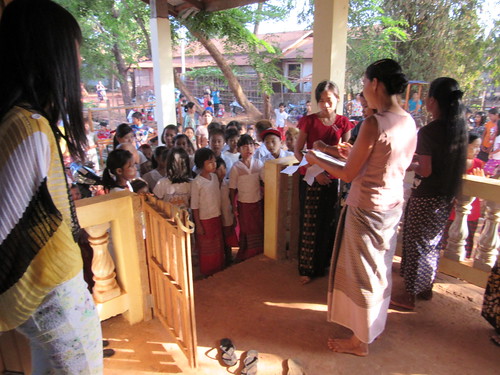 Children patiently waiting to enter the Drop In Centre.
Children patiently waiting to enter the Drop In Centre.
The children were then admitted and were arranged seated on the floor. While they were waiting for the distribution, we gave them various snacks to keep them occupied.
 Distribution of snacks to the waiting children.
Distribution of snacks to the waiting children.
By the time a few hundred children were seated, it was quite difficult to move around. As each child was presented with their distribution, they were encouraged to try on their new uniforms, turning the view into a sea of white and blue.
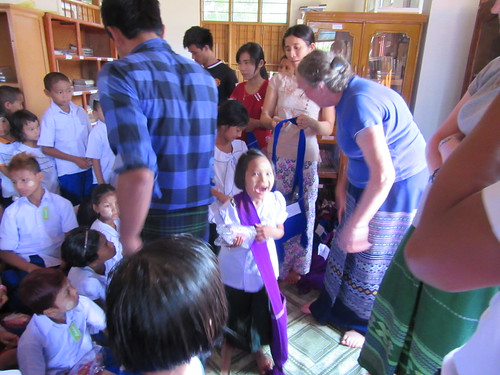 The distribution in progress.
The distribution in progress.
Of course, distribution to the large number of children present took a little time. There was great excitement!
 The children in their new uniforms.
The children in their new uniforms.
When the distribution was complete, we all moved outside for the formal 'group shot' recording the event.
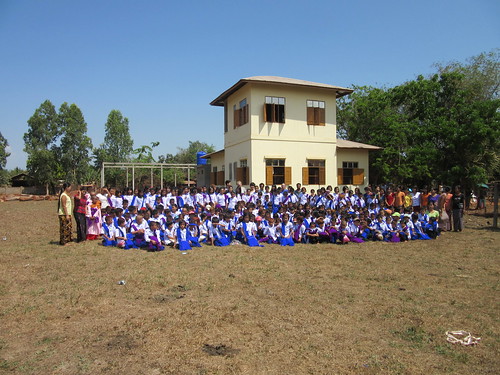 The children pose for photographs outside Ko Dut D.I.C.
The children pose for photographs outside Ko Dut D.I.C.
After all the morning's excitement and loaded down with the things they'd been given, the children then went home on foot or by other means. I photographed one of the motorcycle and sidecar style of three-wheel taxis loaded with an improbable number of children.
 Children leaving the event on a well-loaded motor-cycle taxi.
Children leaving the event on a well-loaded motor-cycle taxi.
A number of volunteers are involved in the operation of the Drop In Centres so the lady who manages Ko Dut, Ma Yu Mon ('Ma' is an honorific, like 'U' for a man) had a meeting with all the assistants present, after which there was a 'Lucky Draw' where each assistant selected a rolled-up coil of paper inscribed with a number indicating their gift. This caused much amusement.
 A meeting of volunteers at the Drop In Centre.
A meeting of volunteers at the Drop In Centre.
We then moved on to a smaller Drop In Centre at La Mine about 7 km east of Ko Dut where the distribution was repeated. We'd also been to La Mine in 2014, briefly described here. There may have been fewer children here, but their enthusiasm was undiminished.
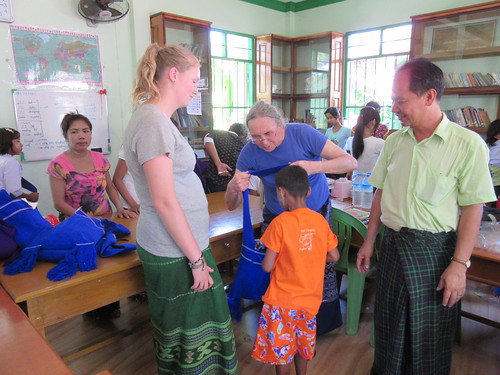 The distribution at La Mine Drop In Centre in 2015.
The distribution at La Mine Drop In Centre in 2015.
After the children had changed into their new uniforms, we all lined up in front of the building for photographs to record the happy event. It's hard to over-estimate the importance of this sort of 'special event' to children who have very little.
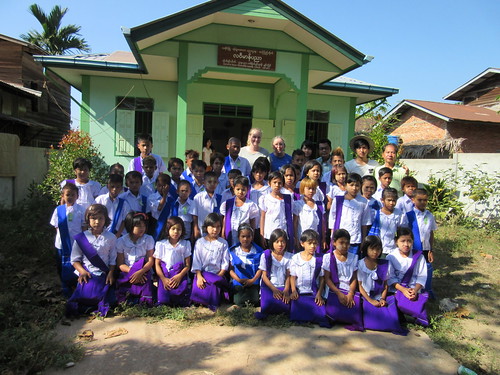 The children, in their new uniforms, at La Mine Drop In Centre.
The children, in their new uniforms, at La Mine Drop In Centre.
The Orphans and Vulnerable Children projects seek to help children who have lost one or both parents through AIDS or other causes or in cases of extreme poverty. Sometimes the children themselves are HIV Positive. In addition to orphanages often run by monasteries or nunneries, it is sometimes possible to place children with foster carers and we visited two such 'O.V.C. Houses' in the area where the Doctor made donations. When these children can be placed in a normal home environment, this surely offers them the best chances in life.
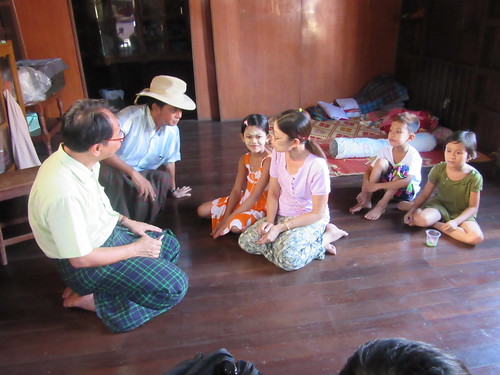 Visiting an O.V.C. House.
Visiting an O.V.C. House.
As the previous year, when we arrived back at Ko Dut Drop In Centre, it had been decided that all the staff and the Doctor's party would go to the beach, so we set off in convoy, the Toyota 'Alphard' driven by the Doctor's friend and numerous motor cycles with the volunteers. After a few miles on sandy tracks, we arrived at the beach. I'm afraid the Doctor's friend drove a little too far and managed to park in deep sand. When he tried to move, we were stuck fast and it took some time to get out, using the tried-and-tested method of finding wood to push under the wheels to give them 'purchase'.
 Releasing the car from the soft sand.
Releasing the car from the soft sand.
The tide was out so I wasn't able to paddle but we decided to take the track which leads across the beach to a monastery which I presume becomes an island at high water. The track was firmer than I expected, except for one short, sandy section where a small stream crosses the track as it nears the sea. The monastery was a peaceful place.
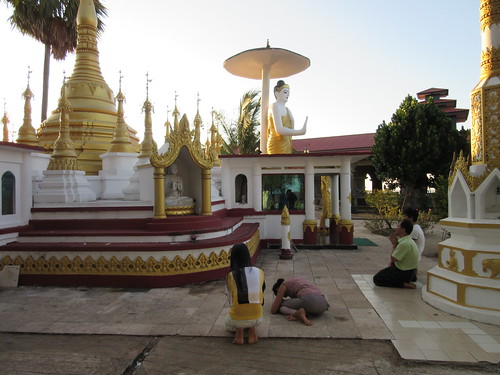 The monastery by the sea.
The monastery by the sea.
We climbed down onto a rocky section of foreshore and explored for a while as it grew dusk.
 Sunset at the monastery.
Sunset at the monastery.
The, we returned to our vehicles and drove back to the beach where the Toyota had become stuck. We all settled into the open beach restaurant nearby and food was ordered. It was becoming dark so the proprietor fished out a rechargeable battery light with a rectangular matrix of light emitting diodes to illuminate our meal. After an enjoyable time at the beach, we drove in the dark back to Ko Dut, where Emily and I had our second night on the floor of the new upper storey, with the rest of our party on the floor downstairs.
In the night, I awoke to a violent storm. Wind was gusting through the building, heavy rain was making quite a noise as it lashed our 'tin' roof and periodically the whole sky, from horizon to horizon, would be lit brightly by sheet lightning. I stood at the window for some time, in awe at the sheer power of nature. When the storm had abated a little, I happily went back to sleep.
Go to next post.
My pictures
Around Mon State, 2015
Mon Ethnic School
Monastery in Ko Dut
Ko Dut D.I.C. 2015
Distribution at Ko Dut D.I.C. 2015
Distribution at La Mine D.I.C.
Around Ko Dut, 2015
My posts on this trip
All my posts on this trip to Myanmar can be found here.
[Actually posted 02/05/2015 03:01, but timestamp amended to place posts in event order. Revisions to text and pictures added 17-May-2015, 26-May-2015, 19-June-2015]
Sunday 19th April 2015
Visit to Ka Mar Wet
From Kot Kha Pon (described in Part 1), we drove a few miles to the Drop In Centre at Ka Mar Wet (also in La Mine Township), which I’d first visited in 2014 (described in the series of posts Burma-2014). As expected, the small building was already full of excited children, from various grades, obediently seated on the floor and monitored by a group of volunteers, many of whom I recognised from my first visit. I was also recognised by the volunteers, there not being many elderly English ladies in La Mine Township.
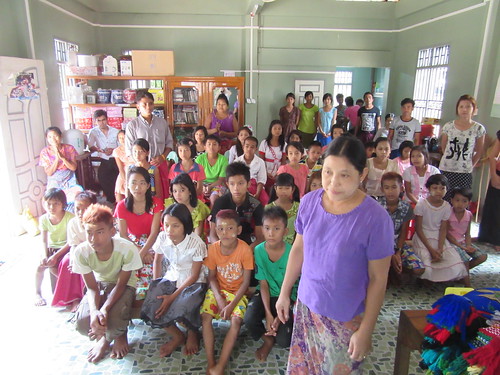 Ka Mar Wet Drop In Centre.
Ka Mar Wet Drop In Centre.
In addition to presenting the ‘kit’ for the new school year (school bag, folding umbrella, supply of exercise books, pencils, eraser, sharpener, Biro, plastic ruler and a school uniform appropriate to the age and sex of each child), a few girls at High School were being given financial assistance to continue their studies. Doctor Hla Tun made the presentation of assistance to these girls first, before carrying out a medical examination on a small boy who had been hurt in an accident with a bicycle a few weeks earlier and had been brought by his concerned mother. The boy didn’t look very happy and he certainly had some nasty abrasions, inexpertly covered by bandages, but a few tests confirmed that there were no broken bones and his mobility was good so the treatment was a course of antibiotics to prevent wound infection and paracetamol for his discomfort during the healing process.
 The injured small boy with his mother.
The injured small boy with his mother.
The distribution had been made easier this time because the staff had placed all the other items in the school bag so Emily and I were able to present the remarkably heavy bag to each student quite easily.
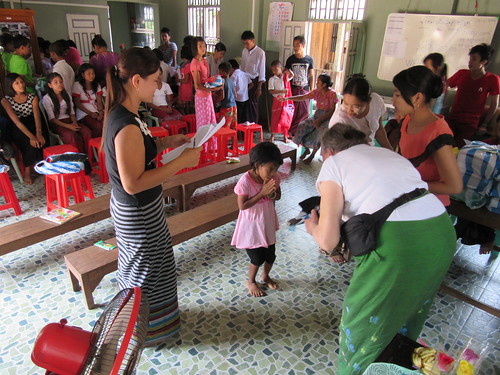 The distribution being received by a young girl.
The distribution being received by a young girl.
After the children had changed into their new uniforms, we then posed for the 'group shot'.
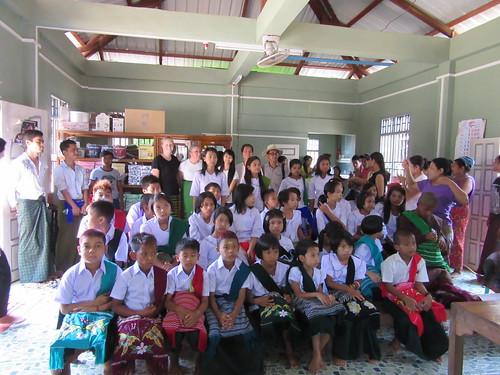 Having changed into their new school uniforms, the children looked very smart.
Having changed into their new school uniforms, the children looked very smart.
We were to sleep at the Ko Dut Drop in Centre, so as to be ready for presentations at Ko Dut the next morning. From Ka Mar Wet, we drove to Thanbyuzayat with its 'Tin Shelter' and paused to look at the 'plinthed' C56 steam locomotive displayed near the end of the 'Death Railway'.
The road to Ko Dut is not great at the best of times but a bridge closed for maintenance meant that we had to take a detour from the usual route. Part of this detour ran across a series of fields so, with heavy traffic in both directions, it seemed more like Stock Car Racing than a public road.
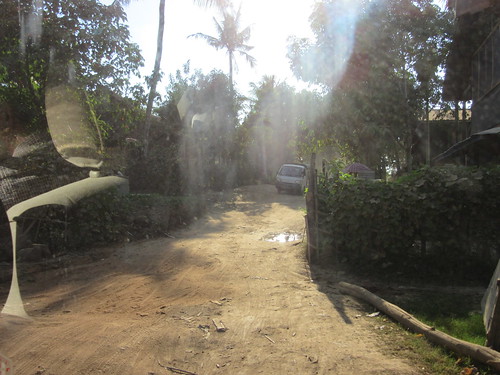 Part of the diversion to Ko Dut.
Part of the diversion to Ko Dut.
We re-joined the ordinary road with some relief. The previous year, we'd examined a Monastic School under construction a little outside Ko Dut but it was clear that work had stopped. Dr. Hla Tun explained that the Head Monk had paused the work at the school so that he could use the budget to 'seal' at least some of the rutted dirt roads by laying coated roadstone ('Tarmac'). As we turned onto these 'sealed' roads we noticed a remarkable improvement in 'ride quality'. We stopped at the house of the manager of Ko Dut D.I.C. and were invited in for snacks before moving to the 'Mon School'.
Go to next post.
My pictures
Ka Mar Wet D.I.C.
Around Mon State, 2015
C56 plinthed at Thanbyuzat
My posts on this trip
All my posts on this trip to Myanmar can be found here.
[Pictures added 15th May 2015]
 The line of full-size painted concrete statues of monks.
The line of full-size painted concrete statues of monks.
 Jan at the at the Win Sein Taw Ya Pagoda in on this trip.
Jan at the at the Win Sein Taw Ya Pagoda in on this trip.
 Our car was severely damaged.
Our car was severely damaged.
 "... all the local people came to inspect the damage ..."
"... all the local people came to inspect the damage ..."
 Our sorry-looking Toyota after the accident.
Our sorry-looking Toyota after the accident.
 The bright, airy cafe at the Services.
The bright, airy cafe at the Services.
 A graphic reminder of the pitfalls of misunderstanding the use of 'western' toilets.
A graphic reminder of the pitfalls of misunderstanding the use of 'western' toilets.













































